Science of the Total Environment ( IF 8.2 ) Pub Date : 2021-09-07 , DOI: 10.1016/j.scitotenv.2021.150157 Pei Lv 1 , Yu Wang 1 , Xiaoyu Zheng 1 , Xiangwei Wu 1 , Qing X Li 2 , Rimao Hua 1

|
Chlorothalonil, a widely used chloroisophthalonitrile fungicide, is highly toxic to aquatic organisms and amphibians. It is essential to understand the persistence and fate of chlorothalonil in aquatic environments. Cyanidin is one of the most common phytopolyphenolics in nature and is a strong antioxidant. This study was designed to understand fate of chlorothalonil and its analogs in surface water in the presence of cyanidin under sunlight and artificial lights. The photodegradation rates of chlorothalonil were increased by 9.6, 19, 26 and 9.1 fold, respectively, under solar, high-pressure mercury lamp (HPML), UV and Xenon lamp light irradiation, in comparison to the cyanidin-free control. Cyanidin also enhanced 2,5-dichloroisophthalonitrile and 2,4,5-trichloro isophthalonitrile (degradation products of chlorothalonil) for 20 and 4.7 fold under HPML irradiation compared to the absence of cyanidin. Chlorothalonil was transformed to 5-chloroisophthalonitrile quantitatively after stepwise dechlorination. The concentration profiles of chlorothalonil and its degradation products were well simulated in the cyanidin-triggered photoreductive dechlorination process, in which donation of hydrogen atom from cyanidin was also agreed by the density functional theory calculations. Cyanidin accelerated photolysis of dichlobenil for 4.3 fold as high as the cyanidin-free control under HPML irradiation. The results warrant an interest in further understanding photolysis of chloroarenes in natural waters and exploring the potential of using phytochemicals to abate chloroarenes-caused pollution.
中文翻译:

水中花青素增强对百菌清、敌菌腈和二氯和三氯间苯二甲腈的选择性、逐步光降解
百菌清是一种广泛使用的氯代间苯二甲腈类杀菌剂,对水生生物和两栖动物有剧毒。了解百菌清在水生环境中的持久性和归宿至关重要。花青素是自然界中最常见的植物多酚之一,是一种强抗氧化剂。本研究旨在了解在阳光和人造光下存在花青素的情况下百菌清及其类似物在地表水中的归宿。与不含花青素的对照相比,在太阳能、高压汞灯 (HPML)、紫外线和氙灯照射下,百菌清的光降解率分别提高了 9.6、19、26 和 9.1 倍。Cyanidin 还增强了 2,5-二氯间苯二甲腈和 2,4,5-三氯间苯二甲腈(百菌清的降解产物)20 和 4。与不存在花青素的情况相比,在 HPML 照射下是 7 倍。百菌清逐步脱氯后定量转化为5-氯间苯二甲腈。在花青素引发的光还原脱氯过程中,百菌清及其降解产物的浓度分布得到了很好的模拟,其中花青素的氢原子捐赠也通过密度泛函理论计算得到了认可。在 HPML 照射下,花青素加速了敌菌素的光解,其速度是不含花青素的对照的 4.3 倍。该结果保证了对进一步了解天然水中氯芳烃的光解和探索使用植物化学物质减少氯芳烃造成的污染的潜力的兴趣。百菌清逐步脱氯后定量转化为5-氯间苯二甲腈。在花青素引发的光还原脱氯过程中,百菌清及其降解产物的浓度分布得到了很好的模拟,其中花青素的氢原子捐赠也通过密度泛函理论计算得到了认可。在 HPML 照射下,花青素加速了敌菌素的光解,其速度是不含花青素的对照的 4.3 倍。该结果保证了对进一步了解天然水中氯芳烃的光解和探索使用植物化学物质减少氯芳烃造成的污染的潜力的兴趣。百菌清逐步脱氯后定量转化为5-氯间苯二甲腈。在花青素引发的光还原脱氯过程中,百菌清及其降解产物的浓度分布得到了很好的模拟,其中花青素的氢原子捐赠也通过密度泛函理论计算得到了认可。在 HPML 照射下,花青素加速了敌菌素的光解,其速度是不含花青素的对照的 4.3 倍。该结果保证了对进一步了解天然水中氯芳烃的光解和探索使用植物化学物质减少氯芳烃造成的污染的潜力的兴趣。在花青素引发的光还原脱氯过程中,百菌清及其降解产物的浓度分布得到了很好的模拟,其中花青素的氢原子捐赠也通过密度泛函理论计算得到了认可。在 HPML 照射下,花青素加速了敌菌素的光解,其速度是不含花青素的对照的 4.3 倍。该结果保证了对进一步了解天然水中氯芳烃的光解和探索使用植物化学物质减少氯芳烃造成的污染的潜力的兴趣。在花青素引发的光还原脱氯过程中,百菌清及其降解产物的浓度分布得到了很好的模拟,其中花青素的氢原子捐赠也通过密度泛函理论计算得到了认可。在 HPML 照射下,花青素加速了敌菌素的光解,其速度是不含花青素的对照的 4.3 倍。该结果保证了对进一步了解天然水中氯芳烃的光解和探索使用植物化学物质减少氯芳烃造成的污染的潜力的兴趣。是 HPML 照射下不含花青素的对照的 3 倍。该结果保证了对进一步了解天然水中氯芳烃的光解和探索使用植物化学物质减少氯芳烃造成的污染的潜力的兴趣。是 HPML 照射下不含花青素的对照的 3 倍。该结果保证了对进一步了解天然水中氯芳烃的光解和探索使用植物化学物质减少氯芳烃造成的污染的潜力的兴趣。







































 京公网安备 11010802027423号
京公网安备 11010802027423号